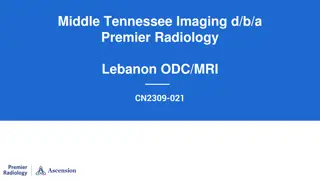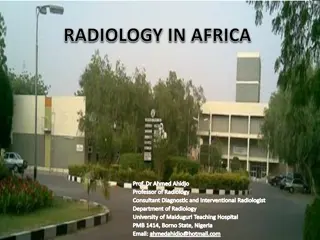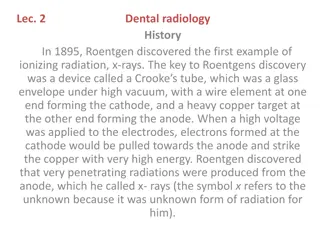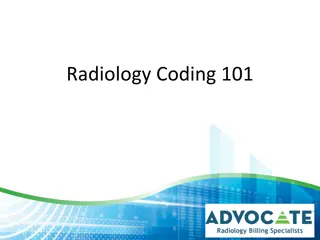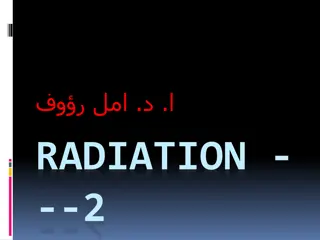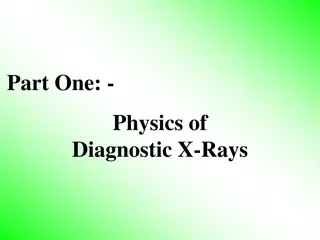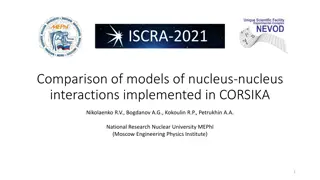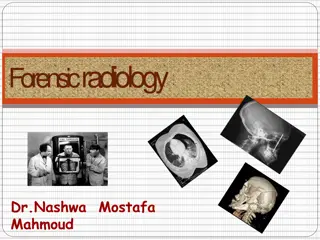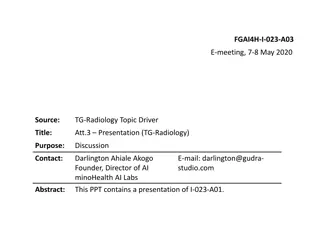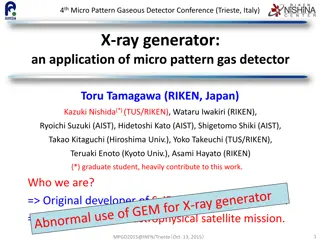Understanding X-Ray Production and Interactions in Radiology
Explore the fundamentals of X-ray production, including the types of ionizing radiation and interactions of photons with matter. Learn about the photoelectric effect, Compton effect, and characteristics of X-ray tubes, essential for radiology professionals and students. Delve into the mechanisms behind the generation of X-rays, their wavelengths, energies, and their applications in diagnostic imaging. Gain insights into the components of X-ray tubes and the processes involved in creating high-quality radiographic images.
Download Presentation

Please find below an Image/Link to download the presentation.
The content on the website is provided AS IS for your information and personal use only. It may not be sold, licensed, or shared on other websites without obtaining consent from the author. Download presentation by click this link. If you encounter any issues during the download, it is possible that the publisher has removed the file from their server.
E N D
Presentation Transcript
RADIOLOGY-3 Fourth Professional UNIT 3 Dr. Ramesh Tiwary Assistant Professor Deptt. of Vet. Surgery and Radiology
PRODUCTION OF X-RAYS
Ionising Radiation Particulate or corpuscular alpha, beta particle, protons, electrons, neutrons, nuclear fragments. Electromagnetic radiation Heat waves, light waves, infra-red rays, U/V-rays, x-rays, gamma rays.
Wave length to x-ray 0.1 to 0.5 A0 (1A0 = 10- 10 cm) Energy - 25 to 125 Kev. Diagnostic x-ray: 30 150 kVp. Coherent scattering: A photon interacts with an object and changes its direction. Subject does not absorb the photon and photon energy does not changed. Degrade image quality, strike radiographer, increased personal exposure.
Photoelectric effect When x-ray photons interact with inner shell (K, L, M shell) electron of atom, free electron fly off as photoelectric and get absorbed in the body. Outer electrons shift to the inner shell gives off energy in the form of radiation called characteristic radiation or line radiation. Photoelectric effect z3 and inversely proportional to 1/E3. By using high kVp photoelectric effect decrease thus patient dose decreased. Photoelectric effect is responsible for formation of image on radiographs of object.
Bremstrahlung or breaking or General or white radiation when electron passing through positive nucleus of target get deflected or slow lose in kinetic energy Compton effect: - Moderate or high energy photon encounters free electron of the outer shell of the atom. Compton effect produces almost all the scatter radiation encountered in diagnostic radiology. Compton effect of x-ray independent of atomic number of absorbing material.
X-RAY TUBE It consists of a glass tube (12-18cm L, 9cm D) which has been evacuated to produce a high vacuum and into which are sealed two electrodes, the cathode (-) and the anode (+) placed 1-3cm apart. Cathode Anode Glass Envelope CATHODE Tungsten target set in anode face. Spiral filament in focusing cup.
CATHODE . Cathode:- Negative side of the x-ray tube, its filament consists of tungsten atomic no. 74 and melting point 33700C. Tungsten has little tendency to vaporise, thus it prolongs the life of the x-ray tube. Focusing cup: - Filament is embedded in a concave metal shroud called focusing cup made of nickel or molybdenum.
ANODE Positive side of the x-ray tube. It is termed the target, because it is the origin of the X-ray beam it is also spoken of as the focus or focal spot. 99% of kinetic energy in the collision converted into thermal energy and 1% irradiated as x-rays. Cathode filament and its focusing cup are so constructed that the beam of electrons focused on this relatively small area.
Types of Anod Stationary type used in dental x-ray machine as portable x-ray units where high current power not required. Consists of copper block embedded with tungsten rhenium alloy metal.
Rotating type Rotating type Consists of a molybdenum disc coated with a strip of tungsten rhenium alloy. Advantage over stationary type is better heat dissipation, provides larger target area for electron beam to interact. Size of focal spot in x-ray machines varies from 0.3 to 3 mm and angle should not less than 150.
Diagram Of A Rotating Anode Tube Rotating disc target of anode Glass Tube Emitted Rad Cathode
Heel effect Heel effect: - Radiation intensity as high as 40% on the cathode side of the x-ray beam than on the anode side is called heel effect. while taking radiograph of unequal thickness, thicker or denser side should be positioned towards the cathode. Smaller angle of anode more pronounced heel effect. When film size larger and focal film distance are less heel effect more noticeable.
Quantity of x-ray production Tube current (Milliamperage or mA) Increasing mA increases the x-ray output. Tube potential (KVP):- If KVP is doubled the x-ray quantity increase by a factor of four. Increase in KVP by 15% would require a reduction in mAs by one half. Focal film distance: - X-ray intensity varies inversely to the squire of the distance between the target and focal spot.
Type of x-ray machines Portable x-ray machine 70 to 110 KV and 15 to 35 mA. Mobile x-ray machine - 90 to 150 KV and 40 to 300 mA. Fixed x-ray machine 120 to 150 KV and 300 to 1000 mA.


